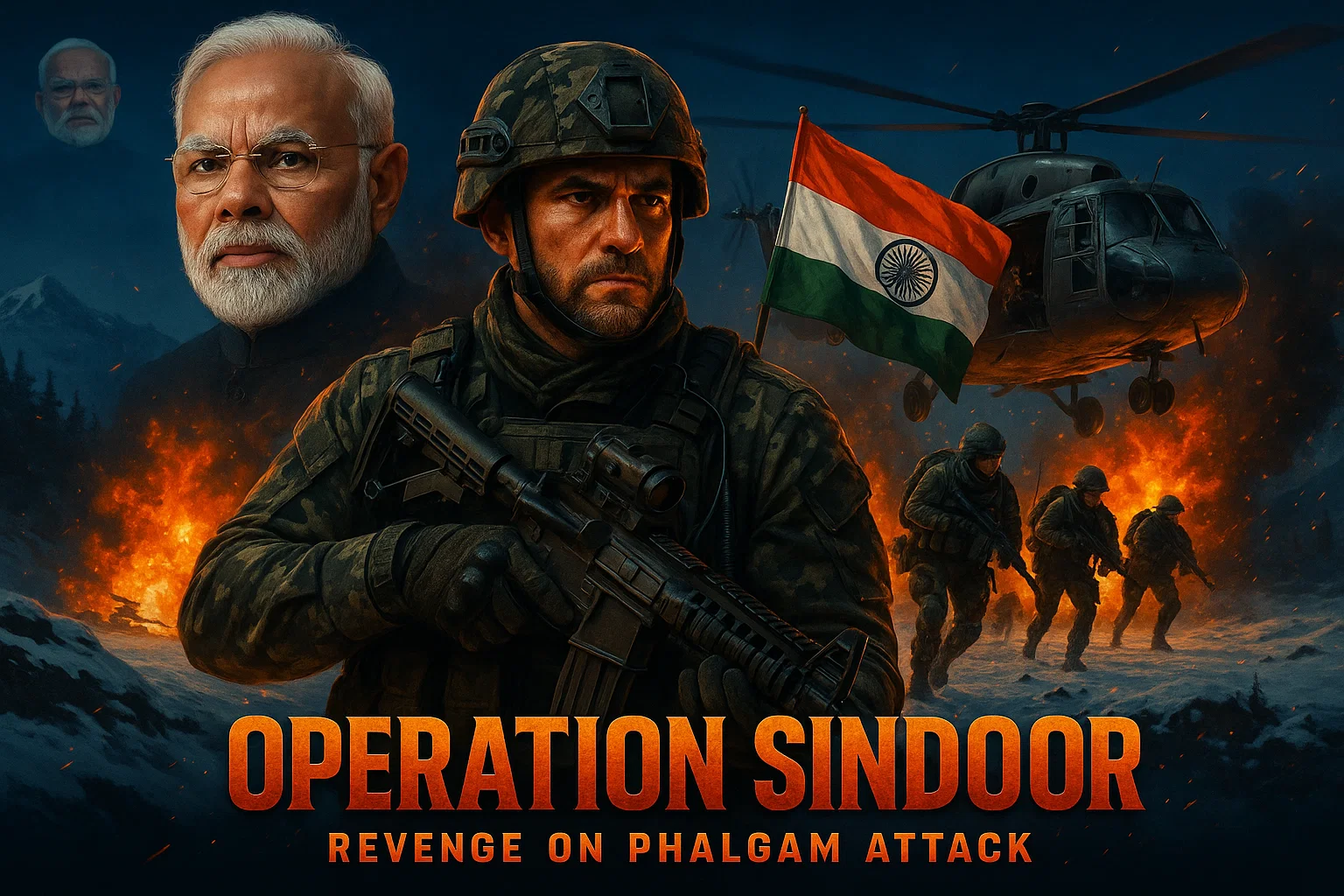Operation Sindoor was India’s bold military response to the Pahalgam terror attack. Here’s what really happened, why it was necessary, and how it shook the enemy to the core.
🔥 Introduction: The Attack That Crossed the Line
On April 21, 2025, terrorists launched a cowardly and brutal attack near Pahalgam in South Kashmir. Heavily armed militants ambushed a CRPF convoy and later opened fire in a busy market, killing security personnel and innocent civilians — including a 9-year-old girl.
India had seen many terror attacks before. But this one? It was personal. It was well-planned, crossed every red line, and provoked a united nation.
Within days, the government of India — led by Prime Minister Narendra Modi — launched a covert and high-intensity counter strike called Operation Sindoor.
Table of Contents
🛡️ Why the Name “Operation Sindoor”?
In Indian culture, sindoor (vermillion) is sacred — it symbolizes honor, sacrifice, and protection of family. Naming the operation “Sindoor” was a tribute to:
- The martyrs’ families,
- The women who lost sons, husbands, and brothers, and
- The spirit of India, which never bows down to terror.
This was more than a military operation — it was an emotional reply from a wounded but powerful nation.
🎯 What Was Operation Sindoor All About?
✅ 1. Targeted Strike in Anantnag Region
The Indian Army, backed by local intelligence, zeroed in on the terror module responsible for the Pahalgam attack. Over 100 soldiers from elite units were deployed in the Anantnag forest belt.
✅ 2. Real-Time Intelligence
Using drone surveillance, mobile intercepts, and local informants, the Army confirmed:
- Locations of 7 terrorists hiding in a cave.
- Cross-border support and funding links.
- Ammunition caches and human shields being used.
✅ 3. Coordinated, Multi-Agency Operation
This was no random raid. It was surgical and precise, involving:
- Indian Army’s Para SF units
- Jammu & Kashmir Police
- RAW and Military Intelligence (MI)
- Air support for emergency evacuation
Operation Sindoor lasted nearly 72 hours with intense gunfire and combat in rugged terrain.
💣 The Impact: What Did India Achieve?
🎯 Elimination of Key Militants
7 high-profile terrorists were neutralized, including a Pakistan-trained commander who planned the Pahalgam ambush.
🎯 Arms Cache Recovered
India recovered:
- AK-47s, M4 rifles
- IEDs and grenades
- Satellite phones and Pakistani currency
🎯 Crackdown on Terror Network
The operation led to the arrest of over 20 overground workers (OGWs) — local supporters of terror groups — breaking the chain of logistics and shelter.
⚖️ Was It Legal? Yes, 100%.
Many youths ask — “Is it legal to hit back like this?”
The answer is YES, and here’s why:
- The operation took place inside Indian territory.
- It was carried out under AFSPA and UAPA laws.
- It followed India’s constitutional duty to protect its citizens under Article 355.
- And if required, India could even justify cross-border action under Article 51 of the UN Charter (Right to Self-Defense).
So no — this wasn’t revenge. It was justice backed by law.
🗣️ What PM Modi Said After the Operation
“We will not forget, we will not forgive. Those who attack our people must pay a price. Operation Sindoor was just the beginning.”
– PM Narendra Modi
The Prime Minister’s tone was clear: India is not the India of 2008 or 1999. This is New India. We talk peace, but we also act when pushed too far.
🇮🇳 Why This Matters to You, the Youth of India
If you’re a college student, job seeker, or just a proud Indian — here’s why Operation Sindoor matters:
- It shows the strength of India’s defence forces.
- It tells the world that terrorism will never defeat democracy.
- It reminds us that law and justice are stronger than bullets.
More importantly, it proves that leadership, courage, and strategy — when backed by law — can protect a billion people.
10 Detailed FAQs on Operation Sindoor.
❓ 1. What is Operation Sindoor?
Operation Sindoor was a strategic counter-terror operation conducted by Indian security forces in April 2025, targeting militants responsible for the Pahalgam terror attack in Jammu & Kashmir. It was a joint mission involving the Indian Army, J&K Police, and intelligence agencies.
❓ 2. Why was it named “Sindoor”?
The term Sindoor symbolizes honor, sacrifice, and womanhood in Indian culture. The name reflects a tribute to the families and martyrs affected by the Pahalgam attack, especially women who lost their loved ones in service to the nation.
❓ 3. What triggered Operation Sindoor?
The operation was launched in direct response to the Pahalgam terror attack on April 21, 2025, in which CRPF jawans and civilians, including a child, were killed by Pakistan-backed terrorists. It was India’s legal and strategic retaliation.
❓ 4. Was Operation Sindoor a surgical strike across the border?
No. Operation Sindoor was conducted within Indian territory, particularly in the Anantnag forest region of South Kashmir. It was not a cross-border surgical strike but a domestic counter-terror operation under Indian law.
❓ 5. How many terrorists were eliminated during Operation Sindoor?
According to official sources, 7 heavily armed terrorists were neutralized. These included high-value targets, such as the mastermind behind the Pahalgam ambush and a foreign-trained militant commander.
❓ 6. What laws were applied during the operation?
Operation Sindoor was conducted under:
- AFSPA (Armed Forces Special Powers Act)
- UAPA (Unlawful Activities Prevention Act)
- Indian Penal Code (IPC)
These laws empower Indian forces to act in disturbed areas and against designated terror groups.
❓ 7. Did the operation involve only the Army?
No. It was a joint operation that included:
- Indian Army’s Special Forces
- Jammu & Kashmir Police
- Military Intelligence (MI)
- RAW and IB
Such coordination ensured precise execution with minimal civilian impact.
❓ 8. What kind of equipment or tactics were used?
The operation used:
- Drone surveillance
- Thermal imaging
- Night-vision combat gear
- Cordon and search tactics
This mix of modern tech and local intelligence helped track down and eliminate the terrorists effectively.
❓ 9. Was the operation legal under international law?
Yes. Since the strike occurred within India’s own borders, and targeted non-state actors engaged in terrorism, it aligns with both Indian constitutional law and Article 51 of the UN Charter (Right to Self-Defense).
❓ 10. What message does Operation Sindoor send to India’s enemies?
Operation Sindoor sends a clear, firm message:
“India will not tolerate terrorism, and every act of terror will be met with lawful, strategic, and powerful retaliation.”
It reinforces India’s stance as a strong, sovereign nation that values peace but responds decisively when provoked.
📌 Conclusion: Sindoor Wasn’t Just a Strike — It Was a Message
Operation Sindoor wasn’t just about guns and bullets. It was about sending a clear message to terrorists and their handlers:
“If you hurt one Indian, we will hold ten accountable — within the bounds of our law, and with the force of our will.”
India responded with lawful rage, strategic precision, and zero compromise. That’s the India we all stand for.
🔗 More Articles You Might Like:
📣 What do YOU think about Operation Sindoor?
Drop a comment below or share your thoughts on Instagram/Twitter with #OperationSindoor

